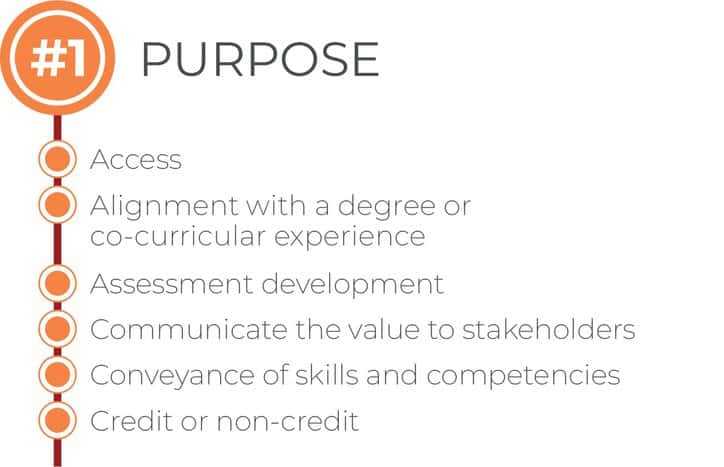Key Factors to Consider When Developing Microcredentials

Microcredentials are used by higher education institutions for multiple purposes that include adding knowledge, skills, or competencies that complement a major, to providing a pathway to certificate or degree programs. Though they vary significantly in their uses, they can provide benefits to learners, universities, and employers alike.
Ways Microcredentials Can Be Used
Integrating Microcredentials into Undergraduate Experiences
In 2021, Strada-Gallup survey data on non-degree credentials, including microcredentials, emphasized the value that college graduates place on non-degree credentials (Strada Center for Education Consumer Insights: July 28, 2021). In comparison to people with only a college degree, those with college degrees and non-degree credentials reported stronger agreement that their combined education helped them achieve their goals, was worth the cost, and made them more attractive job candidates. And non-degree credentials issued by higher education institutions garnered the highest rating from respondents.
In a new report – Integrating Microcredentials into Undergraduate Experiences – Workcred and The University of Texas System designed a framework that can help guide the development and implementation of microcredentials. The report also outlines several factors that should be considered when deciding to create a new microcredential or integrating one developed by an external organization.

Factors to Consider when Developing or Selecting a Microcredential
Some of the key factors include:
Purpose
Before deciding whether to create a new microcredential or use an existing one, it is critical to determine its purpose, such as whether it should it highlight a specific skill or skill bundle, demonstrate a skill specialization, or convey that a student has applied skills through an experiential learning opportunity. To determine purpose, faculty should consider the skill level the learners will
achieve by earning the microcredential, what skills the microcredential will represent, who should value or recognize the microcredential, will it be embedded in a degree program or offered as a curricular experience, and will there be prerequisites to enroll in the microcredential.
Conveyance of Skills and Competencies
Microcredentials should focus on skills and competencies. To identify these skills and competencies, colleges and universities can use their internal research capabilities or work with external vendors to conduct a labor-market analysis. The skills identified should then be validated within each level of employer organization (e.g., practitioner, supervisor, hiring manager) to ensure that the correct skills are being identified. Discussions with employers should also be held to ensure that the skills represented by the microcredential are relevant to what is needed in the job roles and to determine if employers will recognize the microcredential as part of their hiring process.
Governance Structure
To maintain quality and value of microcredentials, a governance structure should be established. Though there is not one governance structure that fits every college or university, one key feature of most is that there is usually a university-wide committee that is charged with developing and implementing a process to award microcredentials. This committee is also usually responsible for developing definitions that will be used either within a campus or a system to ensure consistency of the microcredentials awarded. And if a system-wide approach is used, there can be a level of flexibility for the individual campuses within the system built in.
View the Full Report
For more information about the other factors that should be considered when developing or implementing microcredentials, as well as the framework to develop and integrate microcredentials into undergraduate experiences; insights on the use and purposes of microcredentials; promising microcredential practices in digital skills and data analytics; and approaches to align data analytics microcredentials with undergraduate experiences, see: Integrating Microcredentials into Undergraduate Experiences.






